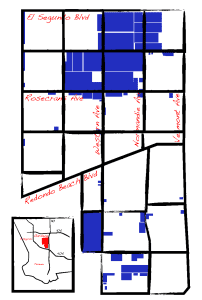The history of Gardena matches the development of Southern California with a couple of notable exceptions. From Spanish land grant, to small ranchos, a strong period of industrial growth, to today’s reliance on international trade. The unusual Japanese and Asian influence gives Gardena its unique characteristic, mostly to the positive because of the industrious nature of the Japanese culture. Interestingly, there were two waves of Japanese immigration. One in the early 1900’s as farm labor and again in the 1980’s with the arrival of the global-scale Japanese corporations. The Gardena development plan of mostly smaller industrial property is also significant.
Location is Gardena’s best economic asset. It’s equidistant from Downtown Los Angeles, LAX and the Ports. It also is relatively accessible to executive housing in West Los Angeles, Palos Verdes, and the Beach communities. It is in the center of an excellent freeway network with the 110, 405, 105, and 91 all bisecting the City. For companies that rely on a transportation network whether air, sea, or road, Gardena is the sweet spot, despite short-sightedness in the City’s zoning regulations. Finally, the climate is particularly mild because of the ocean breezes that drift across the basin, while being far enough away to avoid the fog.
On a business level, the history of Gardena is fruitful – not only because of its agricultural heritage, but because of its industry. During all the great wars, World War II, Korean War, and Vietnam, the small Gardena machine shops kept humming along supplying parts to the major aircraft contractors. The machine shops ran for a couple generations finally slowing down in the mid 1980’s when many of the primary contractors left California for other states. Since that time, Gardena has diversified its industrial base, unfortunately not participating fully because of its old industrial stock and smaller parcels which makes assemblage difficult. Still, location and access has made Gardena prosperous for many smaller companies. In many respects, Gardena represents the Jeffersonian ideal of yeoman farmers eventually yielding to self-made industrialists, on a smaller scale.
Making deals in Gardena is a little different than other locales. It has mostly small buildings, under 20,000 square feet. Many of these properties have been held for generations and suffer from considerable obsolescence. Still the improvements have value and demolition in most cases is not a solution. More importantly the real estate techniques in Gardena are different than other places because of its unique history, long-time ownership and development plan.
Especially today, in the post-recession world, most the industrial sales activity has gravitated to larger Industrial because that’s where the money is. So far, real estate investment finance has not trickled down to the smaller deals. Yes, SBA financing is relatively plentiful and for Sellers who simply want to cash out, a buyer with an SBA loan is completely viable. However many Sellers do not want to pay the capital gains taxes because of their low basis and older sellers would prefer an income stream rather than a taxable lump sum. This is where some of underused techniques are applicable to Gardena’s unusual ownership base.
In times of tight finance, Sellers may want to consider carrying back paper, wrapping underlying finance, or negotiating loan assumptions with their current lenders. The advantages are many. Sellers can defer taxes until a time when they have lower tax rates. Get a higher yield on carrying paper. Convert income into the portfolio category that can be offset from other losses. And plan to have a long payout, if desired, secured by real estate they know. Many times, when Seller’s carry paper they also obtain a higher sale price and interest rate than the market would otherwise dictate. Of course, the essential element is to have at least 20% equity in the property or other guarantees to protect against default.
At one time, so-called creative finance was very common. These are techniques often used in the sale of smaller residential apartments. Because most industrial brokers today focus on major leasing assignments and sales for larger institutions and corporations, many are no longer versed in these once very common techniques. Owners of long-held property who want to preserve cash flow, increase yield and defer taxes can find carry back financing and other related techniques extremely useful.
Finally, techniques that I describe above do have statutory pitfalls based on many years of case law. Matters of recourse, non-recourse, due-on-sale and anti-deficiency laws, as a few examples, require legal review. AITD loans with interest overrides requires an accountant’s assistance. In other words, while the economic benefits can be substantial, Seller’s need to make use of experts in these types of instruments. These are sophisticated real estate techniques that if done properly can provide more positive outcomes that all cash sales – depending of course, on the seller’s goals.
Too often property is placed for sale and owners do not consider other more beneficial methods that would have considerable benefits. One reason is there is not enough knowledge in the brokerage community. Another reason is for bigger deals there are more practical ways to sell and finance real estate. However, in Gardena, as in other similar communities, the specific nature of the industrial property lends itself to creative techniques that are not as widely used as they could be.

